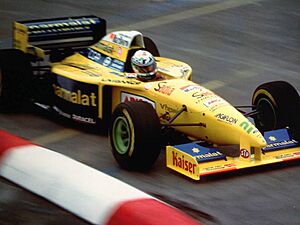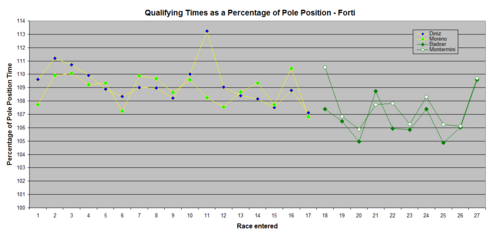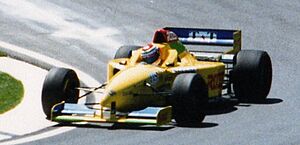Forti facts for kids
| Full name | Parmalat Forti Ford (1995) Forti Grand Prix (1996) |
|---|---|
| Base | Alessandria, Italy |
| Founder(s) | Guido Forti Paolo Guerci |
| Noted staff | Giacomo Caliri Daniele Coronna Riccardo de Marco Cesare Fiorio Hans Fouche Carlo Gancia Chris Radage Sergio Rinland George Ryton Giorgio Stirano |
| Noted drivers | |
| Formula One World Championship career | |
| First entry | 1995 Brazilian Grand Prix |
| Races entered | 27 (43 starts from 54 entries) |
| Constructors' Championships |
0 |
| Drivers' Championships |
0 |
| Race victories | 0 (best result: 7th, 1995 Australian Grand Prix) |
| Podiums | 0 |
| Points | 0 |
| Pole positions | 0 (best result: 19th, 1996 Brazilian Grand Prix) |
| Fastest laps | 0 (Best: 10th, 1996 Monaco Grand Prix) |
| Final entry | 1996 British Grand Prix |
Forti Corse, often called Forti, was an Italian motor racing team. It is best known for its short time in Formula One in the mid-1990s. The team started in the late 1970s. For about 20 years, it raced in smaller racing series.
Forti had many wins in these lower categories. They won four Drivers' Championships in Italian Formula Three in the 1980s. They also won races in the International Formula 3000 championship. Forti raced in F3000 from 1987 to 1994. In 1992, one of the team's founders, Guido Forti, made a deal with a rich Brazilian businessman, Abílio dos Santos Diniz. This deal gave Diniz's son, Pedro Diniz, a permanent spot on the team. It also gave Forti enough money to think about joining Formula One.
Forti joined Formula One as a car builder and team in 1995. But their first car, the Forti FG01, was not very good. The team did not score any championship points. Even with this problem, Forti had a three-year agreement with Pedro Diniz. This agreement ended when Pedro moved to the Ligier team for the 1996 season. He took most of the team's sponsor money with him.
Despite losing money, Forti kept racing. They built a much better car called the Forti FG03. But the team faced big money problems during the season. A deal with a group called Shannon Racing did not work out. Forti stopped competing mid-season. The team raced in 27 Grands Prix in total. They never scored any points. Forti is seen as one of the last truly independent teams in Formula One. This was a time when many big car makers were getting more involved in the sport.
Contents
Forti's Beginnings and Early Success
Forti was started by two Italian businessmen in the late 1970s. They were Guido Forti, a former race car driver, and Paolo Guerci, an engineer. Their team was based in Alessandria, a city in northern Italy. Forti began racing in smaller categories like Formula Ford and Formula Three. They competed in both Italian and European races.
The team had good equipment and quickly started winning. Many Forti drivers went on to race in Formula One. These included Franco Forini, Enrico Bertaggia, Emanuele Naspetti, and Gianni Morbidelli. They won Italian Formula Three titles in 1985, 1987, 1988, and 1989. In 1988, Bertaggia won the famous Macau Grand Prix and the Monaco Grand Prix F3 support race. Morbidelli won the FIA European Formula Three Cup in 1989. Forti continued racing in Formula Three until the end of 1992. Then, they decided to focus only on International Formula 3000.
Racing in Formula 3000
For the 1987 season, Forti moved up to International Formula 3000. They didn't have as much success right away as they did in Formula Three. This was mainly because of the car chassis they chose. Instead of using cars from well-known companies like Lola or March, Forti used a car from their Italian Formula Three supplier, Dallara. This was Dallara's first F3000 car.
Forti was the first team to use this car, called the Dallara 3087. The team was new to F3000, and the car was untested. They didn't score any points in their first F3000 year. Forti used 1988 to gain valuable experience. This helped the team do better in later seasons. They also switched to more competitive cars from Lola and then Reynard.
After a full season in 1988, Forti started to improve. In 1989, Claudio Langes scored the team's first F3000 points. In 1990, Gianni Morbidelli won Forti's first F3000 race. Even though no Forti driver won a championship title in this series, the team became a frequent front-runner. They scored nine wins and five pole positions in International F3000.
From 1993 onwards, Forti focused only on F3000. They had drivers like Naspetti, Fabrizio Giovanardi, Andrea Montermini, and Hideki Noda. The 1991 season was Forti's best in F3000. Naspetti finished third in the Drivers' Championship. By 1994, Forti was the most experienced team in the championship.
Formula One Racing
Getting Ready for F1
As his team became more successful, Guido Forti started thinking about moving up to Formula One. He knew that many teams had tried to move from F3000 to F1 and failed because they didn't have enough money. Forti believed a strong financial base was most important for success. So, in 1991, he began working on his Formula One plan.
At the end of 1992, he made a deal with a wealthy Brazilian driver, Pedro Diniz. Pedro's family was very rich and had many sponsors. This greatly increased the team's money. Pedro's father, Abílio dos Santos Diniz, owned a large distribution company and a supermarket chain in Brazil. The Diniz family helped get sponsorship deals with big brands like Parmalat and Marlboro. This money helped fund Pedro's racing career.
By 1993, Forti met Carlo Vallarino Gancia, an Italian-Brazilian businessman. Gancia became a co-owner of the team. He worked to get a good budget for Formula One by late 1994. This money was mostly supported by the Diniz family. Gancia also hired experienced people, including designer Sergio Rinland and former Ferrari team manager Cesare Fiorio. A retired driver, René Arnoux, also joined as a coach for Diniz.
With this financial help and new staff, Forti was ready to join Formula One in 1995. The Diniz family's companies provided financial stability for the short term. They had a budget of about $17 million for the first year. This was also the first year of a planned three-year contract with Diniz and his supporters.
The Forti FG01 Car
The hardest part for the team was designing and building their own car for the first time. Formula One rules required them to build their own car, not buy one from a supplier. Guido Forti's first F1 car, the Forti FG01, was old-fashioned, too heavy, and very slow. Some people called it "a revised F3000 car" or even "a fearful pile of junk."
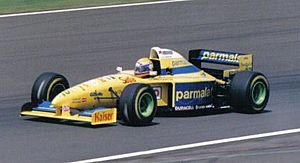
The FG01 had many design influences. Designer Sergio Rinland helped create the car. He worked with experienced Italian engineers Giorgio Stirano and Giacomo Caliri. The car's shape and airflow were designed by Hans Fouche. However, many believed the FG01 was just a re-worked version of an older car from another team.
The FG01 was not expected to perform well. It looked blocky and heavy. Its design meant it didn't have good grip or handling. It also used a small Ford-Cosworth ED V8 engine. This engine had about 100 bhp less than the most powerful engines in F1. It was also the only car in 1995 to have a manual gearbox. The car was yellow and blue with bright green wheels. These colors were a tribute to Ayrton Senna, a famous Brazilian driver who had died in 1994.
The 1995 Season
Forti's main driver for 1995 was Pedro Diniz. He was a rookie (first-year driver) who had raced for Forti in F3000. He was guaranteed a spot because his family and sponsors paid a large part of the team's budget. The second driver was Roberto Moreno, a more experienced Brazilian driver. He had last raced in F1 in 1992.
Before the season, Forti tested their car a lot. But Diniz was about seven seconds slower per lap than the fastest cars. This showed the team would likely be at the back of the field. In the first race, the Brazilian GP, Diniz finished 10th. But he was seven laps behind the winner, Michael Schumacher. In Argentina, both drivers finished nine laps behind the winner. They were not officially counted in the results because they didn't complete enough of the race.
Forti was already the subject of jokes in the racing world. They were much slower than other teams that also struggled financially. However, the team's budget allowed them to make improvements to the car. During the season, they made the car 60 kilograms lighter. They also added a semi-automatic gearbox and improved the car's design. The number of staff also doubled. These changes slowly made the car faster throughout the year.
Forti's finishing record was good for a new team. Diniz gained a reputation as a steady driver. When another team, Simtek, stopped racing, Forti moved up. They started to match the pace of Pacific, another struggling team. At the German GP, both Forti cars qualified faster than the Pacific cars for the first time.
At the last race of the season in Adelaide, Forti seemed to be in a good position for 1996. Moreno qualified within 107% of the fastest time. This was important because a new 107% rule would be used in 1996 to decide who could race. Diniz got the team's best F1 result, finishing seventh. This was just one spot away from scoring points. Even without points, Forti finished 11th in the Constructors' Championship.
Despite the progress, 1995 was seen as a failure. The team spent a lot of money on a car that wasn't very good. Diniz's reputation as a serious F1 driver was hurt. The only good things were the car's reliability and the Diniz family's commitment to fund the team for two more years.
The 1996 Season
The 1996 season looked promising for Forti. They had a good base and a healthy budget. They planned to get more powerful engines. There were even rumors that the Minardi team might merge with Forti to survive. However, these hopes were crushed when Pedro Diniz left Forti to join the Ligier team. He took all the sponsors brought by his family, like Parmalat and Marlboro, with him. Forti's budget was severely cut.
For a while, it looked like the team might not race at all in 1996. Their new car was delayed. Forti had to start the season with an updated version of their old car, the FG01B. This car had a slightly better engine but was still slow. Forti signed Luca Badoer and Andrea Montermini as drivers. Both brought some personal money to the team.
In the first race, the Australian GP, Badoer and Montermini failed to qualify. They were too slow for the new 107% rule. But they both qualified for the races in Brazil and Argentina. In Argentina, Badoer crashed with Diniz, and his car flipped over. Luckily, he was not hurt. Both cars failed to qualify again at the Nürburgring.
Forti introduced a new car, the Forti FG03, at the Imola race. The drivers said it was much better than the old car. It had better grip and was easier to control. But only one FG03 was ready. Badoer qualified the new car, but Montermini failed to qualify in the old one. Badoer finished 10th, but had car problems. In Monaco, both drivers qualified. But Montermini crashed before the race, and Badoer crashed during the race.
Deal with Shannon Racing
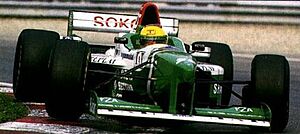
After the Monaco GP, there were rumors that Forti might not survive the season. A deal was announced for a group called Shannon Racing to buy 51% of the team. Shannon Racing was an Irish company that wanted to get into Formula One. This deal seemed to save Forti.
For the Spanish GP, the cars appeared in new green, white, and red colors, like the Italian flag. This seemed to confirm Shannon Racing's purchase. But both drivers failed to qualify again. At the Canadian and French Grands Prix, both Forti cars made it to the grid. However, they often retired from races.
By this time, Forti's money problems were getting worse. This was due to a disagreement over who owned the team: Guido Forti or Shannon Racing. Both cars retired from the French GP with "engine problems." Many believed this was because the team ran out of engine use as they owed money to their engine supplier, Cosworth.
Bankruptcy and End of the Team
Guido Forti claimed that Shannon Racing had not paid him any money as agreed. He said they did not own 51% of his team. As the team ran out of money, it was unclear if they would even show up at the British GP. Forti did take part, but the cars only completed a few laps in practice. They didn't set a fast enough time to qualify. This was because they owed more money to Cosworth and had very little engine use left.
The team made it to the next race, the German GP. But both cars stayed in the pit garage and were not put together. The engine supply had finally been cut off. Guido Forti decided to pull the team from the German GP while he tried to sort out the ownership dispute with Shannon. He hoped to get more sponsors to race in the Hungarian GP. Shannon, however, said they still owned 51% of the team. They wanted to solve Forti's money problems and replace Guido Forti as team boss. Guido Forti took them to court.
While the ownership dispute was being decided, Forti's situation was bad. The team faced big fines for missing races. Forti withdrew his team from the sport. They did not appear at the Hungarian GP or any other races that year. Luca Badoer and Andrea Montermini were left without teams. The promising FG03 car would not race again. By the time Shannon Racing won the court case in September, Forti no longer existed.
Forti's Legacy
Forti's departure from Formula One also meant the end of a team that had been successful in International Formula 3000 and other smaller racing series. Many people agree that Forti might have done well if they had their 1995 budget and the better FG03 car at the same time. But when Pedro Diniz left, the team had little chance of survival.
Forti is another example of a small, struggling team that couldn't afford its dreams in Formula One. It was one of the last "privateer" teams to join the sport. This was a time when big car manufacturers were becoming more involved. Some people thought that teams like Forti didn't deserve a place in F1. The FIA (F1's governing body) introduced the 107% rule in 1996. This rule made slower teams improve or leave the sport.
However, Forti F1 cars have been used for other things since then. Some FG03 cars are now used for F1-themed track days in the United Kingdom. People can drive them on famous race tracks like Rockingham.
Racing Record
Championships and Wins
| Year | Championship/Race | Chassis | Engine | Driver |
|---|---|---|---|---|
| 1977 | Italian Formula Ford 2000 Drivers' Championship | Osella | Ford | |
| 1979 | Argentine Formula Three Drivers' Championship | Martini | Toyota | |
| 1985 | Italian Formula Three Drivers' Championship | Dallara | Alfa Romeo | |
| 1987 | Italian Formula Three Drivers' Championship | Dallara | Alfa Romeo | |
| 1988 | Italian Formula Three Drivers' Championship | Dallara | Alfa Romeo | |
| Macau Grand Prix | Dallara | Alfa Romeo | ||
| Grand Prix de Monaco F3 | Dallara | Alfa Romeo | ||
| 1989 | Italian Formula Three Drivers' Championship | Dallara | Alfa Romeo | |
| European Formula Three Cup | Dallara | Alfa Romeo |
International Formula 3000 Results
(key) (bold means pole position; italics means fastest lap)
| Year | Chassis | Engine | Tyres | Driver(s) | 1 | 2 | 3 | 4 | 5 | 6 | 7 | 8 | 9 | 10 | 11 | Points | TC |
|---|---|---|---|---|---|---|---|---|---|---|---|---|---|---|---|---|---|
| 1987 | Dallara 3087 | Cosworth V8 | A | SIL | VAL | SPA | PAU | DON | PER | BRH | BIR | IML | BUG | JAR | 0 | NC | |
| Ret | 16 | Ret | Ret | ||||||||||||||
| DNQ | |||||||||||||||||
| 1988 | Dallara 3087 Lola T88/50 |
Cosworth V8 | A | JER | VAL | PAU | SIL | MNZ | PER | BRH | BIR | BUG | ZOL | DIJ | 0 | NC | |
| DNQ | DNQ | DNQ | DNQ | 7 | 16 | DNS | DNQ | DNQ | 11 | Ret | |||||||
| DNQ | DNQ | DNQ | DNQ | DNQ | |||||||||||||
| DNQ | DNQ | ||||||||||||||||
| DNQ | |||||||||||||||||
| 1989 | Lola T89/50 | Cosworth V8 | A | SIL | VAL | PAU | JER | PER | BRH | BIR | SPA | BUG | DIJ | 7 | 9th | ||
| 12 | Ret | Ret | 7 | 2 | 6 | 9 | 15 | 9 | 7 | ||||||||
| 1990 | Lola T90/50 | Cosworth V8 | A | DON | SIL | PAU | JER | MNZ | PER | HOC | BRH | BIR | BUG | NOG | 20 | 7th | |
| 8 | Ret | 3 | Ret | 4 | 1 | Ret | Ret | Ret | 7 | 3 | |||||||
| 1991 | Lola T91/50 Reynard 91D |
Cosworth V8 | A | VAL | PAU | JER | MUG | PER | HOC | BRH | SPA | BUG | NOG | 43 | 3rd | ||
| 10 | 9 | DNQ | DNS | 1 | 1 | 1 | 1 | Ret | 6 | ||||||||
| 12 | 5 | DNQ | 8 | Ret | 13 | 8 | 6 | DNS | 4 | ||||||||
| 1992 | Reynard 92D | Cosworth V8 | A | SIL | PAU | CAT | PER | HOC | NUR | SPA | ALB | NOG | MAG | 44 | 2nd | ||
| 6 | 1 | 16 | 2 | 4 | Ret | ||||||||||||
| 1 | 1 | 4 | Ret | ||||||||||||||
| Ret | Ret | 11 | 5 | 7 | Ret | 7 | 8 | 5 | Ret | ||||||||
| 1993 | Reynard 93D | Cosworth V8 | A | DON | SIL | PAU | PER | HOC | NUR | SPA | MAG | NOG | 20 | 5th | |||
| 1 | 10 | 4 | Ret | 4 | 5 | 13 | 9 | 4 | |||||||||
| Ret | Ret | DNQ | 7 | Ret | 16 | 14 | 11 | 14 | |||||||||
| 1994 | Reynard 94D | Cosworth V8 | A | SIL | PAU | CAT | PER | HOC | SPA | EST | MAG | 9 | 7th | ||||
| Ret | Ret | 10 | Ret | Ret | 9 | 4 | Ret | ||||||||||
| 5 | Ret | Ret | 3 | Ret | 7 | 16 | 11 |
Complete Formula One Results
(key) (bold means pole position; italics means fastest lap)
| Year | Chassis | Engine | Tyres | Drivers | 1 | 2 | 3 | 4 | 5 | 6 | 7 | 8 | 9 | 10 | 11 | 12 | 13 | 14 | 15 | 16 | 17 | Points | WCC | |
|---|---|---|---|---|---|---|---|---|---|---|---|---|---|---|---|---|---|---|---|---|---|---|---|---|
| 1995 | FG01 | Ford EDD 3.0 V8 | G | BRA | ARG | SMR | ESP | MON | CAN | FRA | GBR | GER | HUN | BEL | ITA | POR | EUR | PAC | JPN | AUS | 0 | NC | ||
| 10 | NC | NC | Ret | 10 | Ret | Ret | Ret | Ret | Ret | 13 | 9 | 16 | 13 | 17 | Ret | 7 | ||||||||
| Ret | NC | NC | Ret | Ret | Ret | 16 | Ret | Ret | Ret | 14 | DNS | 17 | Ret | 16 | Ret | Ret | ||||||||
| 1996 | FG01B FG03 |
Ford ECA Zetec-R 3.0 V8 | G | AUS | BRA | ARG | EUR | SMR | MON | ESP | CAN | FRA | GBR | GER | HUN | BEL | ITA | POR | JPN | 0 | NC | |||
| DNQ | 11 | Ret | DNQ | 10 | Ret | DNQ | Ret | Ret | DNQ | DNP | ||||||||||||||
| DNQ | Ret | 10 | DNQ | DNQ | DNS | DNQ | Ret | Ret | DNQ | DNP | ||||||||||||||
|
|
||||||||||||||||||||||||
Images for kids
-
Hideki Noda driving for the Forti International Formula 3000 team during the 1994 season.



